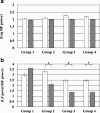The influence of various distractions prior to upper gastrointestinal endoscopy: a prospective randomized controlled study
- PMID: 30157771
- PMCID: PMC6114187
- DOI: 10.1186/s12876-018-0859-y
The influence of various distractions prior to upper gastrointestinal endoscopy: a prospective randomized controlled study
Abstract
Background: Although many patients still have anxiety about upper gastrointestinal (GI) endoscopy, there have been few reports on the influence of distractions for a person who is going to undergo upper GI endoscopy soon. This study was a prospective randomized controlled study investigating the influence of distractions, such as auditive and visual distractions using subjective and objective assessments including autonomic nervous function prior to upper GI endoscopy.
Methods: 206 subjects who underwent upper GI endoscopy as regular health check-ups were divided randomly into 4 groups prior to upper GI endoscopy; group 1 (control group), group 2 (auditive group), group 3 (visual group), and group 4 (combination group). We measured vital signs, autonomic nervous function, profile of mood state (POMS), and the impression for upper GI endoscopy pre- and post-distraction in the 4 groups.
Results: There was no significant difference in vital signs between 5 and 15 min after sitting in group 1, however, several vital signs in all distraction groups improved significantly after distraction (Pulse rate (P): p < 0.001 in group 4; blood pressure: p < 0.05 in group 2, 3, 4) and the rate of decrease in P and diastolic blood pressure was highest in group 4 (p < 0.001). Several scores of POMS and the impression for upper GI endoscopy post-distraction improved significantly compared to pre-distraction between distraction groups and the satisfaction for distraction was highest in group 4 (p < 0.01). Regarding autonomic nerve function, the low- frequency power/ high- frequency power ratio post-distraction was significantly lower than that pre-distraction in all distraction groups (p < 0.001).
Conclusions: Although auditive distraction alone and visual distraction alone were effective, a combination distraction was more effective than any other distraction by subjective and objective assessments. These distractions, which were simple and safe, may play an assistive role in the stability of physical and psychological conditions prior to upper GI endoscopy.
Trial registration: This trial was registered in the University Hospital Medical Information Network (UMIN) Clinical Trials Registry as UMIN000022801 . Registered on 10 July 2016.
Keywords: Autonomic nervous system; Distraction; Esophagoscopy; Image; Music; Vital signs.
Conflict of interest statement
Ethics approval and consent to participate
Written informed consent was obtained from all subjects. The study protocol was approved by the Ethics Committee in Shikoku Central Hospital of the Mutual Aid Association of Public School teachers and this study was performed in accordance with the Declaration of Helsinki. This trial was registered in the University Hospital Medical Information Network (UMIN) Clinical Trials Registry as UMIN000022801.
Consent for publication
Not applicable.
Competing interests
The authors declare that they have no competing interests.
Publisher’s Note
Springer Nature remains neutral with regard to jurisdictional claims in published maps and institutional affiliations.
Figures



Similar articles
-
Effects of audio and visual distraction on patients' vital signs and tolerance during esophagogastroduodenoscopy: a randomized controlled trial.BMC Gastroenterol. 2020 Apr 21;20(1):122. doi: 10.1186/s12876-020-01274-3. BMC Gastroenterol. 2020. PMID: 32316918 Free PMC article. Clinical Trial.
-
Visual distraction alone for the improvement of colonoscopy-related pain and satisfaction.World J Gastroenterol. 2015 Apr 21;21(15):4707-14. doi: 10.3748/wjg.v21.i15.4707. World J Gastroenterol. 2015. PMID: 25914482 Free PMC article. Clinical Trial.
-
Effects of Music Therapy on the Cardiovascular and Autonomic Nervous System in Stress-Induced University Students: A Randomized Controlled Trial.J Altern Complement Med. 2016 Jan;22(1):59-65. doi: 10.1089/acm.2015.0079. Epub 2015 Dec 15. J Altern Complement Med. 2016. PMID: 26669417 Clinical Trial.
-
Highlights from the 52nd Seminar of the Korean Society of Gastrointestinal Endoscopy.Clin Endosc. 2015 Jul;48(4):269-78. doi: 10.5946/ce.2015.48.4.269. Epub 2015 Jul 24. Clin Endosc. 2015. PMID: 26240798 Free PMC article. Review.
-
Highlights from the 50th seminar of the korean society of gastrointestinal endoscopy.Clin Endosc. 2014 Jul;47(4):285-94. doi: 10.5946/ce.2014.47.4.285. Epub 2014 Jul 28. Clin Endosc. 2014. PMID: 25133113 Free PMC article. Review.
Cited by
-
Relieving Anxiety Through Virtual Reality Prior to Endoscopic Procedures.Yonsei Med J. 2023 Feb;64(2):117-122. doi: 10.3349/ymj.2022.0319. Yonsei Med J. 2023. PMID: 36719019 Free PMC article.
-
Classifying metro drivers' cognitive distractions during manual operations using machine learning and random forest-recursive feature elimination.Sci Rep. 2025 Mar 4;15(1):7564. doi: 10.1038/s41598-025-92248-6. Sci Rep. 2025. PMID: 40038461 Free PMC article.
-
The effect of music on pain and subjective experience in image-guided musculoskeletal corticosteroid injections: a randomized controlled trial.Skeletal Radiol. 2020 Mar;49(3):435-441. doi: 10.1007/s00256-019-03298-7. Epub 2019 Aug 21. Skeletal Radiol. 2020. PMID: 31435716 Clinical Trial.
-
Comparison of the Effects of Visual and Auditory Distractions on Fistula Cannulation Pain among Older Patients Undergoing Hemodialysis: A Randomized Controlled Clinical Trial.Geriatrics (Basel). 2020 Sep 16;5(3):53. doi: 10.3390/geriatrics5030053. Geriatrics (Basel). 2020. PMID: 32948045 Free PMC article.
-
Therapeutic effects of Reiki on interventions for anxiety: a meta-analysis.BMC Palliat Care. 2024 Jun 13;23(1):147. doi: 10.1186/s12904-024-01439-x. BMC Palliat Care. 2024. PMID: 38872168 Free PMC article.
References
-
- Brandt L. Patients’ attitudes and apprehensions about endoscopy: how to calm troubled waters. Am J Gastroenterol. 2001;96:280–284. - PubMed
Publication types
MeSH terms
Substances
LinkOut - more resources
Full Text Sources
Other Literature Sources

